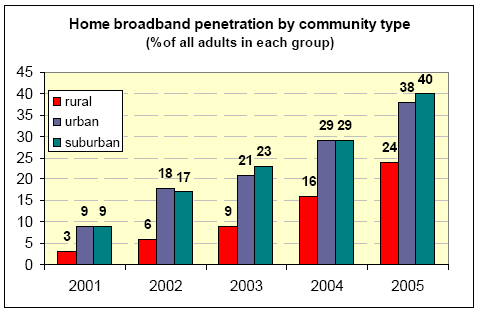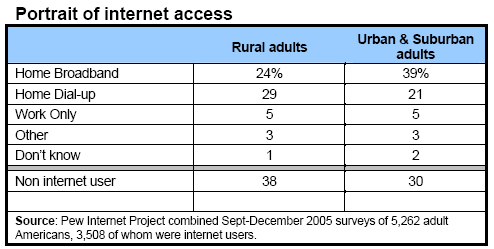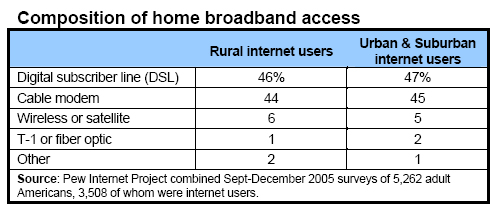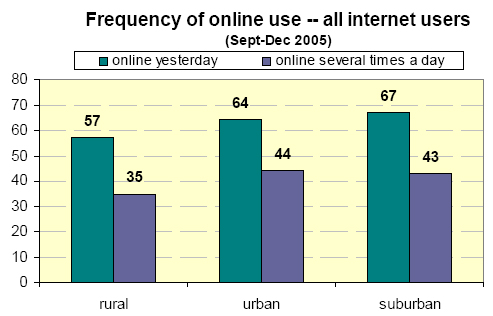24% of rural Americans have high-speed internet connections at home compared with 39% of urban and suburban dwellers
Rural Americans lag the rest of the nation when it comes to use of high-speed internet connections at home, as well as basic measures of online penetration. However, rural areas show fast growth in home broadband uptake in the past two years and the gap between rural and non-rural America in home broadband adoption, though still substantial, is narrowing.
By the end of 2005, 24% of rural Americans had high-speed internet connections at home compared with 39% of adult Americans living elsewhere. In 2003, 9% of rural Americans had broadband at home, less than half the rate (22%) in urban and suburban American. For overall internet use – by whatever connection from any location – the penetration rate for adult rural Americans lagged the rest of the country by 8 percentage points at the end of 2005 (a 62% to 70% margin). This is about half the gap that existed at the end of 2003.

A consequence of the rural broadband adoption gap is that people in rural America use the internet less frequently, on average, than other Americans and do fewer things online on the average day than urban and suburban users. This is not because rural Americans have different tastes about the internet than people in cities or suburban areas; it is because rural Americans, in the aggregate, have a lower penetration rate for a key factor behind the intensity of online use – a home high-speed internet connection.
Portrait of internet access in America
Here is how online access looks when putting rural America next to urban and suburban locales focusing on who is online, who isn’t, and how they connect to the internet.

As to the means by which home broadband users get high-speed access, there is essentially no difference across type of community. Fully 90% of subscribers have cable modems or DSL, with cable and DSL splitting that market share.
Since rural areas are expensive to wire for high-speed access, some advocates for rural broadband hope wireless high-speed may provide a solution. There is not yet much evidence that this is happening on a widespread basis. However, use of fixed wireless or satellite service for high-speed home access has grown from barely 1% in 2002 of home broadband subscribers to 5% by the end of 2005.

Reasons for the gap
Availability of home high-speed service is one likely reason for the rural gap in home broadband adoption. Our February 2004 survey asked respondents with dial-up service at home whether broadband service is available where they live. Among all dial-up users, 58% said broadband was available, 15% said it was not, and 26% didn’t know. For rural dial-up users, 38% said it was available, 27% said it was not, and 35% didn’t know.1
These self-reported numbers are not without problems. Asking people whether the infrastructure in their neighborhood supports a particular service may be hard for some people to answer. They may not know – as a large share of respondents said – and some may be incorrect in whatever answer they do give. However, the internal consistency of the numbers (i.e., that rural users are more likely, as expected, to report lack of availability) suggests that infrastructure is partly behind lower broadband uptake in rural America.2
Other forces are also likely behind the broadband gap. As noted, rural Americans are less likely to have online access by whatever means than non-rural Americans, and lower overall online penetration means lower broadband penetration. Demographics explain to some extent the lower penetration. Rural Americans are, on average, older, less educated, and with lower incomes than people living in other parts of the United States – all factors associated with lower levels of online use.
Overall access to high-speed internet
Since people may have access to high-speed connections at work or at home, the potential reach of broadband access extends beyond just the workplace or just the home front. At work, the broadband gap between rural and non-rural Americans is small and not statistically significant; 72% of rural workers who have online access at work have high-speed connections, compared with 75% of urban and suburban online workers.3
With rural areas lagging in broadband use both at home and (modestly) at work, it is not surprising that the gaps persist when looking at access from home or work. Half of all adult Americans who live in non-rural areas can get online with a fast connection at home or work. By contrast, just more than one-third of rural Americans can do this.

Frequency and intensity of online use
All of this adds up to generally less intense use of the internet by rural Americans than others. This shows up in several ways: the likelihood that a person goes online on a given day, the likelihood a person goes online several times on a typical day, and the number of online activities engaged in on the typical day.4


The differences among rural and non-rural users are not a function of the “rural-ness” of the respondents. That is, a person from rural America, by virtue of where he or she lives, does not have less interest in going online or doing a lot of things online on a given day. Rather, rural America contains more people whose characteristics are associated with low levels of internet use (such as relatively few home high-speed internet users), which brings the averages down for various measures of intensity of online use. In fact, having a high-speed connection at home is the single largest explanatory factor behind intensity of online use – an effect that has grown between 2002 and 2005.5
At an individual level, this means that a rural broadband user should be about as likely as a suburban or urban internet user to be a heavy internet user. As the figure below shows, rural broadband internet users are nearly as likely as non-rural counterparts to use the internet on a given or go online several times a day. The percentage point differences between rural and non-rural broadband users are not statistically significant.6

Comparing online activities for the typical day for broadband users across each community type makes the point more vividly. There is basically no difference for rural broadband users and those in other parts of the country with respect to the number of online activities they do on the average day.

Online activities
There are a number of instances in which, for whatever reason, being a rural American has a real influence on the chances of a user doing a specific online activity.7 These are shown in the table below.

Some of the differences may be carry-overs to the internet of some characteristics embedded in rural life. Rural Americans may be less likely than other Americans to purchase travel services – by whatever means – since the distance from major airports or train stations makes travel more costly. To the extent that some computer games or screensavers are available only at large electronics retailers, less availability of these stores in rural areas might be behind the greater likelihood of rural Americans to get such applications online. The same logic applies for taking classes online for credit and the prevalence of colleges in rural areas.
Other differences may be rooted in how the internet has evolved. Online classified services, such as Craig’s list, are organized around specific cities – and are thus less likely to be of interest to many rural Americans. Although no one knows if there is any geography to blogging, a vague notion that young urban “hipsters” are most tuned in to the blogosphere might be behind blog-reading being less popular in rural areas.
As to online banking, a combination of the availability of online content and rural habits may be at play in rural users’ less frequent use of such banking services. Some rural banks might be less likely to offer online banking or introduced such services later than their urban and suburban counterparts. One could also conjecture that, in some remote rural areas, in-person banking is part of a “going to town” routine that persists even if online banking is available.
Trends
By the end of 2005, 24% of rural Americans had high-speed connections at home, up from 9% at the end of 2003. In comparison, 36% of all Americans have high-speed internet connections at home at the end of 2005, up from 22% at the end of 2003. Rural home broadband penetration has more than doubled while the national average has risen by about two-thirds. From a lower base, adoption of high-speed internet connections at home has been growing faster in rural America than elsewhere in the past two years. Here is a look at trends in broadband internet adoption since the middle of 2000.

Regarding general internet usage, rural adult Americans have consistently lagged their urban and suburban counterparts by a margin that varies between about 11 and 15 percentage points. However, according to our September and December 2005 combined data, 62% of adult rural Americans were internet users compared with 70% of non-rural Americans. This is the narrowest end-of-year difference in overall internet penetration between rural and non-rural Americans that we have recorded.

Three demographic factors are behind the persistent difference in internet penetration between rural and non-rural America. First, rural America has a greater share of old Americans than urban and suburban America, and older Americans go online at lower rates than other age groups. Fully 43% of rural Americans are over the age of 50 (and 18% are over age 65) while 38% of non-rural Americans are over the age of 50, with 16% over 65). Income is another factor. More rural Americans fall in the lower end of the nation’s income distribution; 33% of rural respondents in our September-December data say they live in households with incomes below $30,000 annually compared with 24% of non-rural respondents. Finally, rural Americans are, on average, less educated than urban and suburban Americans; 29% of non-rural Americans have college (or higher) degrees compared to 18% of rural Americans.




